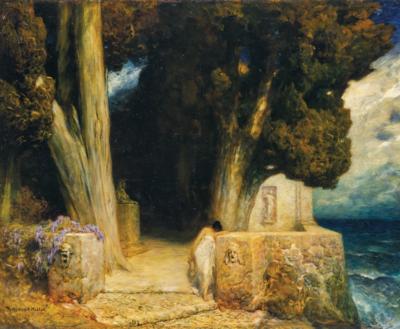Ferdinand Keller
(Karlsruhe 1842–1922 Baden-Baden)
Sappho, signed, dated Ferdinand Keller 1909, oil on canvas, 96 x 121 cm, framed
Provenance:
Sale, Leo Spik, Berlin, 29 June 2017, Lot 108;
Private Collection, Germany.
A certificate issued by Prof. Dr. Helmut Börsch-Supan (25 July 2017) is available upon request.
She is the most famous lyricist of antiquity: the Greek poet Sappho, who sang of love and eros in clear, expressive language. For Plato she was the tenth muse. In our painting, Sappho has just left a grove flanked by mighty cypresses, the location of which is hard to pinpoint, but whose layout is clearly reminiscent of Böcklin's "Isle of the Dead". Here, as there, the viewer enters a walled park directly by the sea. Yet the heavy shade of the evergreen trees, which symbolise death and mourning but also comfort and renewed happiness, denies us access - and its interior remains a mystery. A sphinx at the entrance emphasises the mystical depths of the grove. The figure in the sunlit wall niche on the centre-right is probably Euterpe, the muse of music and lyrical poetry. Sappho's lyre, however, hangs powerless in her right hand, her song - perhaps her last - is finished. The passionate poet leans against the wall in her light, white robe. Her face is hidden in her elbow so that her hair is a deep black focal point in the landscape. The mask of tragedy hung on the wall she has chosen speaks volumes. She is facing it - the mask of comedy opposite no longer attracts attention, it is already overgrown by a delicate purple wisteria, which Keller takes almost verbatim from his painting "Böcklin's Grave" (1901/02).
Ferdinand Keller does not show Sappho's last act of desperation, her dramatic leap from a rock into the sea, but the pause before the final decision. Even the sea’s roar is cautious - it can wait. Not everything has been decided yet, a return to the grove, from whose deep darkness a piece of bright sky shines out as a glimmer of hope, is not blocked, Sappho can still turn back. The picture radiates a poetic mood in this suspended state of deep depression and a decision about to be taken. Only the cloudy sky hints at drama, which, according to legend, ends with Sappho's redemptive fall into the sea. Calm before the fall? That too remains a mystery here.
Ferdinand Keller was celebrated as the "Baden Makart" for his virtuoso, intensive colour work. The monumental version of "Hero and Leander" painted for the Vienna Academy earned him an honourable appointment there in 1882 (which, however, he did not accept). Inspired by Arnold Böcklin, he developed his own style of symbolism around 1900. Both masters share an ability to bring certain natural moods to life through the virtuoso combination of artistic, mystical and painterly elements. The Kunsthalle Karlsruhe noted that this painting is very close to their similarly large "Böcklin's Grave". Further variations on this theme by Keller were auctioned in Munich (Neumeister, 30 November 2011) and Brussels (Bonhams Cornette de Saint-Cyr, 2 April 2023). Due to its lyricism and wealth of allusions, this previously unknown painting is one of the most remarkable pictorial creations of Ferdinand Keller's Symbolist period.
Expert: Mag. Dimitra Reimüller
 Mag. Dimitra Reimüller
Mag. Dimitra Reimüller
+43-1-515 60-355
19c.paintings@dorotheum.at
25.04.2024 - 18:00
- Dosažená cena: **
-
EUR 39.000,-
- Odhadní cena:
-
EUR 15.000,- do EUR 20.000,-
Ferdinand Keller
(Karlsruhe 1842–1922 Baden-Baden)
Sappho, signed, dated Ferdinand Keller 1909, oil on canvas, 96 x 121 cm, framed
Provenance:
Sale, Leo Spik, Berlin, 29 June 2017, Lot 108;
Private Collection, Germany.
A certificate issued by Prof. Dr. Helmut Börsch-Supan (25 July 2017) is available upon request.
She is the most famous lyricist of antiquity: the Greek poet Sappho, who sang of love and eros in clear, expressive language. For Plato she was the tenth muse. In our painting, Sappho has just left a grove flanked by mighty cypresses, the location of which is hard to pinpoint, but whose layout is clearly reminiscent of Böcklin's "Isle of the Dead". Here, as there, the viewer enters a walled park directly by the sea. Yet the heavy shade of the evergreen trees, which symbolise death and mourning but also comfort and renewed happiness, denies us access - and its interior remains a mystery. A sphinx at the entrance emphasises the mystical depths of the grove. The figure in the sunlit wall niche on the centre-right is probably Euterpe, the muse of music and lyrical poetry. Sappho's lyre, however, hangs powerless in her right hand, her song - perhaps her last - is finished. The passionate poet leans against the wall in her light, white robe. Her face is hidden in her elbow so that her hair is a deep black focal point in the landscape. The mask of tragedy hung on the wall she has chosen speaks volumes. She is facing it - the mask of comedy opposite no longer attracts attention, it is already overgrown by a delicate purple wisteria, which Keller takes almost verbatim from his painting "Böcklin's Grave" (1901/02).
Ferdinand Keller does not show Sappho's last act of desperation, her dramatic leap from a rock into the sea, but the pause before the final decision. Even the sea’s roar is cautious - it can wait. Not everything has been decided yet, a return to the grove, from whose deep darkness a piece of bright sky shines out as a glimmer of hope, is not blocked, Sappho can still turn back. The picture radiates a poetic mood in this suspended state of deep depression and a decision about to be taken. Only the cloudy sky hints at drama, which, according to legend, ends with Sappho's redemptive fall into the sea. Calm before the fall? That too remains a mystery here.
Ferdinand Keller was celebrated as the "Baden Makart" for his virtuoso, intensive colour work. The monumental version of "Hero and Leander" painted for the Vienna Academy earned him an honourable appointment there in 1882 (which, however, he did not accept). Inspired by Arnold Böcklin, he developed his own style of symbolism around 1900. Both masters share an ability to bring certain natural moods to life through the virtuoso combination of artistic, mystical and painterly elements. The Kunsthalle Karlsruhe noted that this painting is very close to their similarly large "Böcklin's Grave". Further variations on this theme by Keller were auctioned in Munich (Neumeister, 30 November 2011) and Brussels (Bonhams Cornette de Saint-Cyr, 2 April 2023). Due to its lyricism and wealth of allusions, this previously unknown painting is one of the most remarkable pictorial creations of Ferdinand Keller's Symbolist period.
Expert: Mag. Dimitra Reimüller
 Mag. Dimitra Reimüller
Mag. Dimitra Reimüller
+43-1-515 60-355
19c.paintings@dorotheum.at
|
Horká linka kupujících
Po-Pá: 10.00 - 17.00
kundendienst@dorotheum.at +43 1 515 60 200 |
| Aukce: | Obrazy 19. století |
| Typ aukce: | Sálová aukce s Live bidding |
| Datum: | 25.04.2024 - 18:00 |
| Místo konání aukce: | Wien | Palais Dorotheum |
| Prohlídka: | 13.04. - 25.04.2024 |
** Kupní cena vč. poplatku kupujícího a DPH
Není již možné podávat příkazy ke koupi přes internet. Aukce se právě připravuje resp. byla již uskutečněna.

